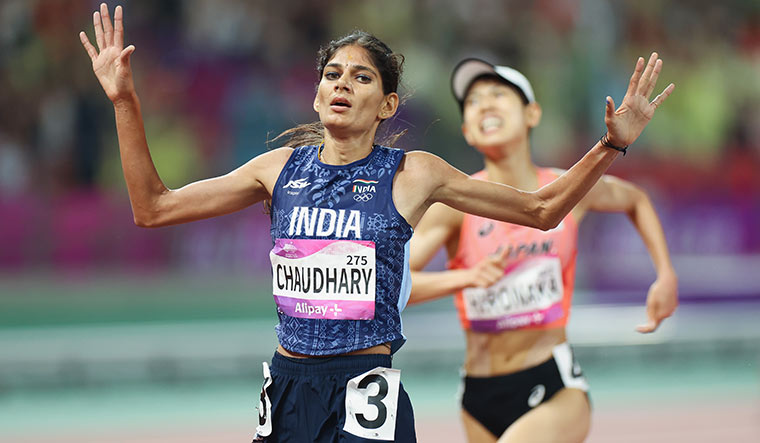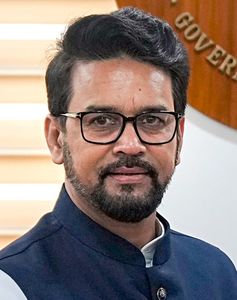Going into the Asian Games in Hangzhou, China, the target set for the contingent was 100 medals. They did seven better, ending with 28 gold, 38 silver and 41 bronze. In an interview with THE WEEK, Union Sports Minister Anurag Thakur talks about how the successful campaign took shape. Excerpts:
How satisfied are you with India’s performance?
It is a historic moment for India and all of us. We said it and we did it! As the sports minister, I am happy that the hard work and determination of our athletes and the vision of Prime Minister Narendra Modi to create a holistic sports ecosystem, combined with the support extended to them through the Target Olympic Podium Scheme and other government funds, have brought about these historic results.
Having achieved the 100-medal target in China, what are your expectations from next year's Paris Olympics?
The training of athletes who are likely to represent India in Paris started two years ago; it is on track. We have recently upgraded facilities at three National Centres of Excellence in Patiala, Bengaluru and Lucknow to provide international-level facilities to our athletes. Besides, we have greatly strengthened our sports science facilities and hired more than 200 experts as high performance managers and directors to improve overall training. All athletes will continue to get overall as well as personalised support from TOPS.
Both kabaddi teams returned with gold medals. How important was it to see them back on top?
It was heartening to see that India won its 100th medal in a traditional sport, and that too through our women athletes. As a matter of policy, we are trying to promote indigenous sports so that the younger generation take them up. In all our Khelo India Games, we have at least five traditional sports, including thang ta, kalaripayat, kho kho and kabaddi.
At these Asian Games, it was very important for the kabaddi teams to reach the top of the podium. I am elated to see our sportspersons holding their nerve in crunch situations. In Jakarta 2018, the women's team were runners-up.
The victory in the men's team final awarded India its eighth men's kabaddi title in nine editions (they got bronze in Jakarta, but avenged their loss in Hangzhou).
Which was your favourite performance in both individual and team categories?
It is difficult to pick a favourite performance. All the athletes—those who have won medals and those who could not—have put in their best performance. Each one of them is a moment to cherish. I will be doing injustice to other athletes if I single out any performance.
Your favourite moment of the Games?
It is a tricky question, but since you are insisting, I would say the way Neeraj Chopra kept his cool and threw the javelin to [win gold] was one of my personal favourites. Even Parul Chaudhary's dash for gold in the 5000m was a show of extreme mental toughness.
Shooting, hockey and archery gave India a clutch of medals. How can we upgrade the other disciplines to their level?
India's performance in athletics and shooting was particularly impressive. We won 22 medals in shooting and 29 in athletics. I believe there are a few key factors that contributed to this surge. First, we have a strong tradition in both. We have produced some excellent athletes in these sports, including Neeraj, Avinash Sable and Manu Bhaker.
Second, we have invested heavily in developing our athletics and shooting programmes. For instance, in shooting and athletics, our athletes trained abroad for a long time before the Games to get a sense of their level of preparedness vis-a-vis other countries.
Third, we have a number of talented young athletes who are coming through the ranks in both athletics and shooting. They are hungry for success. I am confident that India's success in athletics and shooting at the Asian Games is just the beginning. We have the potential to become a global powerhouse in these sports, and we are committed to achieving that goal.
Will the government or the Sports Authority of India set benchmarks like 'Iss baar...' for the Olympics?
It would be hard to put a number just yet because we still have some time to go. We are working with the IOA (Indian Olympic Association) to develop a comprehensive plan for the 2024 Olympics. This plan will identify the key focus areas for our athletes and ensure that they have the best possible chance of success. We have an impressive bench strength in several disciplines and we believe that we have the potential to win more medals than ever. We are investing heavily in sports infrastructure and coaching.
What was key to India's best-ever performance at the Asian Games?
In 2018, we had 70 medals; this time we have 107. A 52 per cent increase in medals between two editions and 75 per cent increase in gold. In 2020, we had our best-ever Olympics, Paralympics and Deaflympics. Of course, it is owing to the hard work of our athletes and others in the sports ecosystem, such as coaches and support staff, that this has been possible.
But our athletes always worked hard; what seems to have changed now?
It is the vision of Prime Minister Narendra Modi, which he put in place in 2014, and his personal interest in sports that have brought about this sea-change. Today, the sports ecosystem in the country has a pyramidal structure—from grassroots to elite—where talent identification and nurturing have become continuous processes. It was Modi ji's vision with which the Target Olympic Podium Scheme was started in 2014. He wanted elite athletes to have all the facilities that they need to bring in results. And today, that scheme and the support that has been extended through it are showing results. Under TOPS, we have two different categories of players—Development and Elite—and for both set of players, the government provides training, diet, foreign exposure, equipment and personalised support to each athlete. They are also given a monthly out-of-pocket allowance of Rs50,000 (for elite athletes) and Rs25,000 (for development athletes), so that they can support their families. In 2018, the Khelo India scheme was introduced to identify talent at the grassroots level and train them to represent India in international competitions. Many Khelo India athletes are now part of the elite TOP Scheme. In fact, 124 Khelo India athletes were part of the Indian contingent this year; most of them are part of TOPS as well. There is definite growth in the athletes' performances and there is support at every level. Khelo India athletes are not just trained in SAI and Khelo India academies in state-of-the-art infrastructure, but are also given free coaching, lodging, diet and an out-of-pocket allowance of Rs10,000 a month. We have also built a lot of sporting infrastructure to ensure that athletes in every corner of India have a place to start their career. As many as 750 Khelo India Centres have been built in districts across the country; by next year, we will take this number to 1,000. The sports budget has also been increased three times in 2022-23, compared with 2013-2014. These concrete steps have helped ensure 360-degree support to athletes. Their hard work is showing results today.
It used to be said that Indians don't have that killer instinct to win. But that is now changing. Reason?
Earlier, India was seen as a nation that did well in sports like wrestling, boxing and shooting, but athletics was seen as an area where the west and African countries dominated. It was felt that we did not have the genes required for excellence in athletics. We have reached the fourth position so many times and missed the medal. But that has changed. I feel Neeraj's Olympic gold in Tokyo has made a huge difference in the mindset of athletes. There is a confidence not only in athletics, but in other sports, too, with which our athletes compete now. Avinash's Commonwealth Games [silver] medal in the 3000m steeplechase, where he beat athletes from Kenya, was another moment where it became clear that we are as good in that discipline. In these Games, Parul... showed the confidence to surpass the Japanese athlete in the last 10 seconds to get the gold. It was evident that, mentally, she did not give up on gold even till the very end. Earlier, they participated with the hope of winning; now they know they can win. They go to win, not participate. That is a big change.



